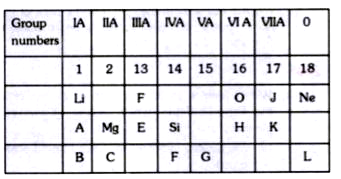An element X of group 15 and period 2 exists as diatomic molecule. It combines with hydrogen and forms ammonia in the presence of a suitable catalyst.
Draw the electron dot structure of ammonia.
Topper's Solved these Questions
- PERIODIC PROPERTIES OF ELEMENTS BOOK - ICSECHAPTER - PERIODIC PROPERTIES OF ELEMENTS EXERCISE - QUESTIONS FOR PRACTICE ON EXAMINATION PATTERN (SECTION I)
2 Videos
- PERIODIC PROPERTIES AND VARIATIONS OF PROPERTIES (PHYSICAL AND CHEMICAL) BOOK - ICSECHAPTER - PERIODIC PROPERTIES AND VARIATIONS OF PROPERTIES (PHYSICAL AND CHEMICAL) EXERCISE - Questions from Previous ICSE Board Papers (2018)
5 Videos
- PERIODIC PROPERTIES AND VARIATIONS OF PROPERTIESBOOK - ICSECHAPTER - PERIODIC PROPERTIES AND VARIATIONS OF PROPERTIESEXERCISE - ASSERTION AND REASON BASED QUESTIONS
5 Videos
Similar Questions
An element X of group 15 and period 2 exists as diatomic molecule. It combines with hydrogen and forms ammonia in the presence of a suitable catalyst.
Draw the electron dot structure of the diatomic molecule, and identify and name the type of bond formed.
View SolutionAn element X of group 15 and period 2 exists as diatomic molecule. It combines with hydrogen and forms ammonia in the presence of a suitable catalyst.
Identify the element X.
View SolutionAn element X of group 15 and period 2 exists as diatomic molecule. It combines with hydrogen and forms ammonia in the presence of a suitable catalyst.
Write the electronic configuration of X and count the number of valence electrons.
View SolutionAn element X of group 15 exists as diatomic molecule and combines with hydrogen at 773 K in presence of the catalyst to form a compound, ammonia which has a characteristic pungent smell
(a) Identify the element X. How many valence electrons does it have ?
(b) Draw the electron dot structure of the diatomic molecule of X. What type of bond is formed in it ?
(c) Draw the electron dot structure for ammonia and what type of bond is formed in it ?
View SolutionConsider the section of the periodic table given below.

Note : In this table B does not represent boron
C does not represent carbon
F does not represent fluorine
H does not represent hydrogen
K does not represent potassium
You must see the position of the element in the periodic table.
Some elements are given in their own symbol and position in the periodic table, while others are shown with a letter. With reference to the table:
Draw the electron dot structure for the compound formed between C and K.
View SolutionAn element is placed in 2nd group and 3rd period of the periodic table, burns is presence of xygen of form a basic oxide
(a) Identify the element
(b) Write the electronic configuration
(c) Write a balanced equation when it burns in the presence of air
(d) Write a balanced when this oxide is dissolved in water
(e) Draw the electron dot structure for the formation of this oxide.
View Solution
Some elements are given in the above table in their own symbol & position in the periodic table, while others [shaded] are shown with a letter. With reference to the table.
Draw the electron dot structure for the compound formed between C and K. potential.
View SolutionWrite the balanced chemical equations for the following reactions and identify the type of reaction in each case.
(a) Nitrogen gas is treated with hydrogen gas in the presence of a catalyst at 773 K to form ammonia gas.
(b) Sodium hydroxide solution is treated with acetic acid to form sodium acetate and water.
(c) Ethanol is warmed with ethanoic acid to form ethyl acetate in the presence of concentrated H2SO4.
(d) Ethane is burnt in the presence of oxygen to form carbon dioxide, water and releases heat and light.
View SolutionAn element X (atomic number 17) reacts with an element Y (atomic number 20) to form a divalent halide
(a) Where in the periodic table are elements X and Y placed ?
(b) Classify X and Y as metal (s), non-metal (s) or metalloid (s)
(c) What will be the nature of oxide of element Y ? Identify the nature of bonding in the compound formed
(d) Draw the electron dot structure of the divalent halide.
View SolutionWrite the formula of the product formed when the element A (atomic number 19) combines with the element B (atomic number 17) Draw its electronic dot structure. What is the nature of the bond formed ?
View Solution
